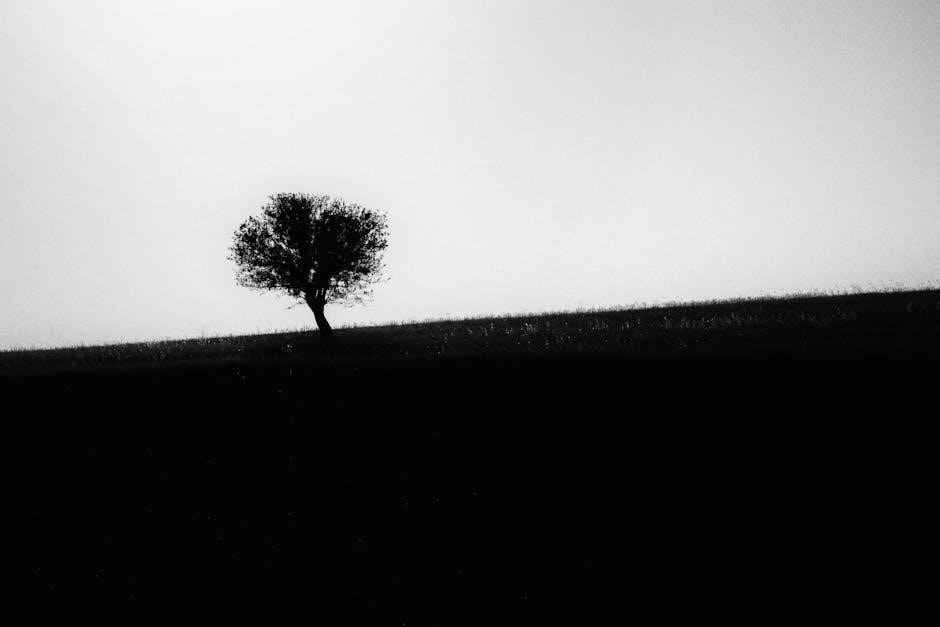Black magick, often shrouded in mystery and controversy, explores the darker aspects of occult practices, delving into forbidden rituals, supernatural influences, and the psychological impact of such arcane traditions on individuals and societies.
Definition and Scope
Black magick refers to the practice of harnessing supernatural or occult powers for purposes deemed malignant, self-serving, or harmful. Rooted in ancient spiritual traditions, it often involves forbidden rituals, necromancy, and demonic invocations. Unlike benevolent magic, which seeks harmony, black magick operates in the shadows, aiming to manipulate or control. Its scope extends across various cultures, from European witchcraft to African and Afro-Caribbean traditions, each with unique practices and taboos. Historically, black magick has been tied to fear and persecution, as societies viewed it as a threat to moral and religious order. Despite its controversial nature, black magick persists, influencing modern occult movements and sparking debates about ethics and power. This section explores the core principles and boundaries of black magick, distinguishing it from other occult practices and examining its psychological and societal implications.
Historical Context
Black magick has its roots in ancient civilizations, where spiritual practices often blurred the lines between benevolent and malevolent intentions. Early evidence of such practices can be traced to Mesopotamia, Egypt, and other cultures, where spells and incantations were used to influence divine forces. The concept of black magick gained prominence during the Middle Ages, particularly in Europe, where it became closely associated with witchcraft and heresy. The Church played a significant role in defining and condemning these practices, leading to widespread persecution and the infamous witch hunts. Over time, black magick evolved, incorporating elements from various occult traditions and forbidden knowledge. Its historical context is deeply intertwined with societal fears, religious doctrines, and the pursuit of power, making it a complex and enduring aspect of human culture. This section explores the origins and development of black magick, shedding light on its transformation across centuries.
Modern Relevance
Despite its ancient origins, black magick continues to hold a significant place in contemporary culture and spirituality. Modern practitioners often reinterpret traditional rituals and spells, blending them with current esoteric trends and personal beliefs. The rise of digital platforms has made black magick more accessible, with numerous online communities and resources dedicated to its study and practice. This resurgence has also sparked debates about ethics, cultural appropriation, and the potential misuse of such powerful traditions. Additionally, black magick has influenced popular culture, appearing in literature, film, and music, which further fuels public interest and curiosity. As society becomes more open to diverse spiritual practices, black magick remains a fascinating yet controversial subject, attracting both adherents and critics. Its modern relevance lies in its ability to evolve while maintaining its mysterious and often misunderstood essence.
History of Black Magick
Black magick traces its origins to ancient civilizations, evolving through medieval persecution, Renaissance occultism, and modern reinterpretations, maintaining its enigmatic presence across centuries of human history and cultural transformations.
Ancient Civilizations and Roots
The roots of black magick can be traced back to ancient civilizations, where early humans sought to influence the forces of nature through spiritual and occult practices. These practices often involved rituals, spells, and incantations aimed at appeasing or controlling supernatural entities. In many cultures, the line between religion and magick was blurred, with shamans and priests serving as intermediaries between the physical and spiritual worlds. The use of charms, talismans, and divination tools was prevalent, reflecting a deep belief in the power of the unknown. As civilizations evolved, so did the perception of magick, with certain practices becoming associated with darkness and malevolence. This shift laid the groundwork for the distinction between white and black magick, with the latter being linked to malevolent intentions and forbidden knowledge.
Medieval Period and Persecution
The medieval period marked a turning point in the perception of black magick, as it became increasingly associated with heresy and evil. The rise of Christianity led to widespread persecution of practitioners, with the Church labeling black magick as a tool of the devil. Witch hunts and trials became common, particularly during the Inquisition, where accused witches and sorcerers faced brutal punishments. The fear of black magick was fueled by religious doctrine, which framed it as a threat to societal order. This era also saw the emergence of grimoires and forbidden texts, which were often used as evidence against accused practitioners. The persecution of black magick practitioners during this time deeply ingrained the notion of its malevolence in Western culture, shaping its reputation for centuries to come. The medieval period remain a dark and pivotal chapter in the history of black magick.
Renaissance and Evolution
The Renaissance brought a shift in the understanding of black magick, blending ancient occult practices with emerging philosophical and scientific ideas. This period saw the rise of prominent figures like Heinrich Cornelius Agrippa and John Dee, who explored the intersection of magic, alchemy, and spirituality. The revival of classical texts and the emergence of secret societies, such as the Rosicrucians, fostered a more organized approach to occult studies. Black magick began to evolve beyond mere superstition, incorporating elements of Hermeticism and Kabbalah. The Renaissance also witnessed the publication of influential grimoires, which systematized rituals and spells, making them more accessible. This era marked a transition from the medieval fear of black magick to a more intellectual and structured practice, laying the groundwork for modern interpretations. The Renaissance thus became a period of both revival and innovation, shaping the trajectory of black magick into the contemporary era.

Practices and Rituals
Black magick encompasses a range of arcane practices, including necromancy, demonic invocations, and forbidden spells, often conducted in secret to achieve specific, sometimes malevolent, outcomes, drawing power from dark, unseen forces and ancient traditions.
Forbidden Rituals and Spells
Forbidden rituals and spells in black magick involve intricate ceremonies and incantations designed to harness dark energies for specific purposes, often linked to manipulation, destruction, or personal gain. These practices, steeped in secrecy and taboo, frequently incorporate ancient symbolism, arcane languages, and rare materials. The rituals may include the invocation of malevolent entities, the casting of curses, or the manipulation of unseen forces to influence events. Such practices are typically performed under precise astrological conditions and require a deep understanding of occult principles. Despite their controversial nature, these rituals remain a fascinating aspect of black magick, drawing both fear and allure from those who encounter them. The ethical implications of such practices are profound, often leading to societal condemnation and persecution of practitioners throughout history. This enigmatic aspect of black magick continues to captivate and unsettle, reflecting humanity’s enduring fascination with the unknown and the powerful forces that lie beyond the veil of reality.
Necromancy and Demonic Invocations
Necromancy, a dark and ancient practice within black magick, involves communication with the deceased to gain insight, power, or control over events. Rooted in early human cultures, it often requires elaborate rituals, sacred symbols, and offerings to bridge the divide between the living and the dead. Demonic invocations, similarly, focus on summoning malevolent entities to achieve specific goals, such as manipulation, destruction, or personal empowerment. These practices are deeply intertwined with forbidden knowledge and secret societies, who guard the rituals and incantations necessary for such summonings. The psychological and ethical implications of these acts are profound, often leading to fear, societal condemnation, and even self-destruction. Despite the risks, necromancy and demonic invocations remain central to black magick, reflecting humanity’s enduring fascination with the unknown and the desire to wield power beyond mortal limits. These practices continue to captivate and unsettle, embodying the darker aspects of human curiosity and ambition.
Secret Societies and Forbidden Knowledge
Secret societies have long been associated with the preservation and transmission of forbidden knowledge, particularly in the realm of black magick. These mysterious groups, often shrouded in secrecy, have historically been custodians of arcane rituals, ancient texts, and hidden truths. Their existence has fueled both fascination and fear, as they operate outside conventional societal norms. Many such societies trace their origins to medieval Europe, where they sought refuge from persecution while safeguarding esoteric wisdom. Practices within these groups often involve intricate rituals, symbolic codes, and the invocation of unknown forces. The pursuit of power, enlightenment, or immortality drives their endeavors, yet the ethical implications of their actions remain deeply controversial. Forbidden knowledge, in this context, is not merely intellectual but often tied to the manipulation of reality itself. These societies remind us that the line between enlightenment and destruction is perilously thin, and the allure of the unknown can be both captivating and perilous.
Regional Variations
Black magick practices vary significantly across cultures, with African and Afro-Caribbean traditions emphasizing ancestral spirits, while European folklore often centers on witchcraft and curses, reflecting diverse cultural and historical influences globally.
European Witchcraft Traditions
European witchcraft traditions are deeply rooted in ancient, pre-Christian practices, often intertwined with folklore and superstition. These traditions were heavily suppressed during the medieval witch hunts, where accused witches faced brutal persecution. The belief in the Devil’s Mark, a supposed sign of a pact with Satan, was a central theme in trials. Historical texts, such as “Cursed Britain” by Thomas Waters, highlight how these practices persisted despite societal condemnation. Modern practitioners draw inspiration from these historical roots, blending old rituals with contemporary spiritual practices. The cultural impact of European witchcraft is evident in literature, art, and popular culture, showcasing its enduring legacy. These traditions continue to evolve, reflecting a blend of ancient beliefs and modern interpretations, making them a significant part of both historical and contemporary occult studies.
African and Afro-Caribbean Influences
African and Afro-Caribbean traditions bring a unique perspective to black magick, blending ancestral spirits, nature-based rituals, and communal practices. Rooted in ancient African religions, these traditions emphasize communication with the spirit world and the use of natural elements like herbs and drums. The transatlantic slave trade dispersed these practices across the Caribbean and Americas, where they evolved into distinct forms such as Vodou in Haiti and Santería in Cuba. These traditions often focus on healing, protection, and divine justice, yet are sometimes misconstrued as “black magic” due to their mysterious nature. Modern practitioners honor their ancestors while adapting rituals to contemporary life, ensuring these traditions thrive. Their influence is seen in global spiritual movements, highlighting the resilience and richness of African diasporic culture. These practices remain a vital part of the black magick landscape, offering profound insights into the interconnectedness of spirit and humanity.
Asian and Middle Eastern Practices
Asian and Middle Eastern traditions significantly contribute to the tapestry of black magick, offering unique rituals and spiritual frameworks. In China, Taoist sorcery emphasizes the manipulation of chi and the balance of yin and yang, often involving intricate rituals to summon spirits or ward off negative energies. Similarly, Japanese Onmyōdō blends Buddhist and Shinto elements, focusing on divination and elemental control. India’s Tantric traditions explore the duality of light and dark, using rituals to invoke powerful deities and achieve transcendence. In the Middle East, Islamic esotericism and Sufi mysticism influence black magick practices, often incorporating the Quran and the concept of jinn to achieve spiritual or material goals. These practices, while deeply rooted in cultural and religious contexts, are frequently misunderstood as “black magic” due to their esoteric nature. Their enduring presence highlights the diversity and richness of global occult traditions, blending ancient wisdom with modern interpretations.

Psychological and Sociological Aspects
Black magick profoundly influences both individuals and societies, often fostering fear and misunderstanding. It shapes psychological states, creating a duality of empowerment and anxiety, while sociologically, it reflects cultural taboos and societal fears of the unknown.

Fear, Superstition, and Perception
Fear and superstition surrounding black magick stem from its association with the unknown and the belief in its destructive power. Many societies have historically viewed black magick as a malevolent force, fearing its potential to harm or manipulate. This perception has been fueled by religious and cultural narratives that often portray black magick as a tool of evil, fostering a deep-seated dread. Superstition has further amplified these fears, with many believing black magick to be a gateway to dark energies or malevolent entities. Such beliefs have led to the marginalization and persecution of practitioners, often based on misunderstandings or exaggerated tales. Media and popular culture frequently perpetuate these stereotypes, reinforcing the notion of black magick as a dangerous and sinister practice. As a result, fear and superstition continue to shape public perception, making black magick a subject of both fascination and apprehension in modern times.
Social Impact and Cultural Influence
Black magick has profoundly influenced societies and cultures, often fostering fear, mistrust, and fascination simultaneously. Historically, its practice has been linked to marginalized groups, leading to persecution and social exclusion. The fear of black magick has shaped laws, religious doctrines, and communal norms, as societies sought to protect themselves from perceived threats. Culturally, black magick has inspired countless works of art, literature, and film, becoming a timeless theme in human storytelling. Its imagery and symbolism have been adopted by various subcultures, blending mysticism with rebellion. Despite its controversial reputation, black magick has also inspired introspection and self-discovery, challenging societal norms and encouraging individuals to explore the unknown. Its dual role as both a feared practice and a source of cultural enrichment underscores its complex legacy, making it a enduring yet divisive force in human history and contemporary culture.
Psychological Effects on Practitioners
Engaging in black magick can have profound psychological effects on practitioners, often manifesting as heightened sensitivity to supernatural beliefs and a deepened sense of personal power. Some individuals report enhanced self-awareness and emotional resilience, while others experience increased anxiety or paranoia due to the perceived risks of invoking dark forces. The practice can lead to a sense of isolation, as societal stigma and fear of judgment may drive practitioners to secrecy. Over time, this isolation can intensify feelings of alienation and emotional turmoil. Conversely, the mastery of complex rituals and forbidden knowledge may foster a sense of accomplishment and confidence. However, the psychological toll of manipulating forces beyond human control can be immense, often leading to mental instability or obsessive behaviors. The intricate balance between empowerment and potential psychological damage makes black magick a double-edged sword for those who dare to explore its mysteries;

Modern Perspectives
Modern perspectives on black magick reveal a blend of fascination and skepticism, with contemporary practices often integrating technology and pop culture, challenging traditional views while sparking debates about ethics, cultural appropriation, and personal responsibility.
Contemporary Practices and Revival
Contemporary practices of black magick have seen a resurgence, blending traditional rituals with modern spirituality and technology. Many practitioners now incorporate digital tools, social media, and online communities to share knowledge and connect globally. This revival reflects a growing interest in esoteric traditions, with younger generations drawn to the mystique and empowerment associated with black magick. While some adhere to historical practices, others reinterpret rituals to align with contemporary values, such as environmentalism or social justice. The internet has become a key platform for disseminating forbidden knowledge, with PDFs, forums, and secret societies flourishing online. However, this accessibility has also sparked debates about cultural appropriation and the dilution of sacred traditions. Despite these challenges, black magick remains a powerful symbol of rebellion and self-discovery, attracting those seeking alternative paths to personal and spiritual growth in an increasingly secular world.

Media Portrayal and Pop Culture
Black magick has long fascinated media and pop culture, often being sensationalized in films, literature, and television. Movies like The Craft and Rosemary’s Baby portray black magick as mysterious and dangerous, while books and series like Harry Potter and The Chilling Adventures of Sabrina romanticize its power. These depictions frequently blur the line between fact and fiction, reinforcing stereotypes of black magick as inherently evil. Pop culture’s obsession with the occult has also influenced fashion, music, and art, with many artists incorporating themes of black magick into their work. Social media platforms, particularly TikTok and Instagram, have further amplified its visibility, with practitioners sharing rituals and spells online. However, such portrayals often oversimplify or distort the complexities of black magick, contributing to widespread misconceptions. Despite this, the allure of black magick in media continues to captivate audiences, reflecting a deep cultural fascination with the unknown and the forbidden.
Legal and Ethical Considerations
Black magick raises significant legal and ethical concerns, as its practices often exist in a gray area between spiritual freedom and societal norms. In many cultures, black magick has historically been criminalized, with laws against witchcraft and sorcery still present in some regions today. Ethical debates surround the use of black magick for harmful purposes, such as curses or manipulation, which challenges moral frameworks. Some practitioners argue that intent determines the ethicality of the practice, while others believe the mere invocation of dark forces is inherently wrong. Legal systems worldwide vary in how they address black magick, with some countries enforcing strict penalties and others embracing it as a form of religious expression. Modern discussions also focus on the balance between personal freedom and societal protection, particularly in cases where black magick is linked to fraud, coercion, or violence. These tensions highlight the complex interplay between law, morality, and the occult.
Black magick, with its roots in ancient mysticism, continues to captivate and unsettle, blending fear, reverence, and the unknown. Its enduring legacy reflects humanity’s dual fascination with power and the darker aspects of existence.
Legacy and Enduring Beliefs
Black magick’s legacy is intertwined with humanity’s fascination with the occult, leaving an indelible mark on cultural and historical narratives. Despite centuries of persecution, its practices and beliefs have persisted, evolving across civilizations. From ancient rituals to modern adaptations, black magick continues to captivate, blending fear and reverence. Its enduring presence in folklore, literature, and contemporary culture underscores its role as a symbol of both power and taboo. The belief in black magick’s efficacy, whether viewed as malevolent or misunderstood, reflects deeper societal anxieties about the unknown and the supernatural. As a result, its legacy remains a complex tapestry of fear, intrigue, and the enduring human quest to harness forces beyond the mundane.
Future of Black Magick
The future of black magick is likely to be shaped by its adaptation to modern societies and technological advancements. As interest in occult practices grows, driven by pop culture and digital accessibility, black magick may evolve into new forms, blending traditional rituals with contemporary influences. However, its controversial nature ensures that it will remain a subject of debate, with ethical and legal challenges persisting. Despite this, the allure of black magick’s power and mystery may attract new generations, ensuring its survival as a secretive yet enduring practice. The internet and global connectivity could also lead to the emergence of hybrid traditions, further diversifying its expression. Ultimately, black magick’s future hinges on its ability to reinvent itself while retaining its enigmatic and often feared reputation.
Final Thoughts and Reflections
In reflecting on black magick, it becomes clear that its significance extends beyond mere superstition or fear. Rooted in ancient practices, it represents a complex interplay of human spirituality, psychology, and the quest for power. While its history is marked by persecution and misunderstanding, black magick also offers insights into the resilience of esoteric traditions. As modern society grapples with its perceptions, it is crucial to approach the subject with an open yet discerning mind, recognizing both its potential for harm and its role in cultural heritage. The enduring fascination with black magick underscores its profound impact on human belief systems, inviting us to reflect on the duality of light and darkness within ourselves and our world. Ultimately, black magick serves as a mirror to humanity’s deepest fears and desires, offering a lens through which we can examine the intricacies of our collective soul.